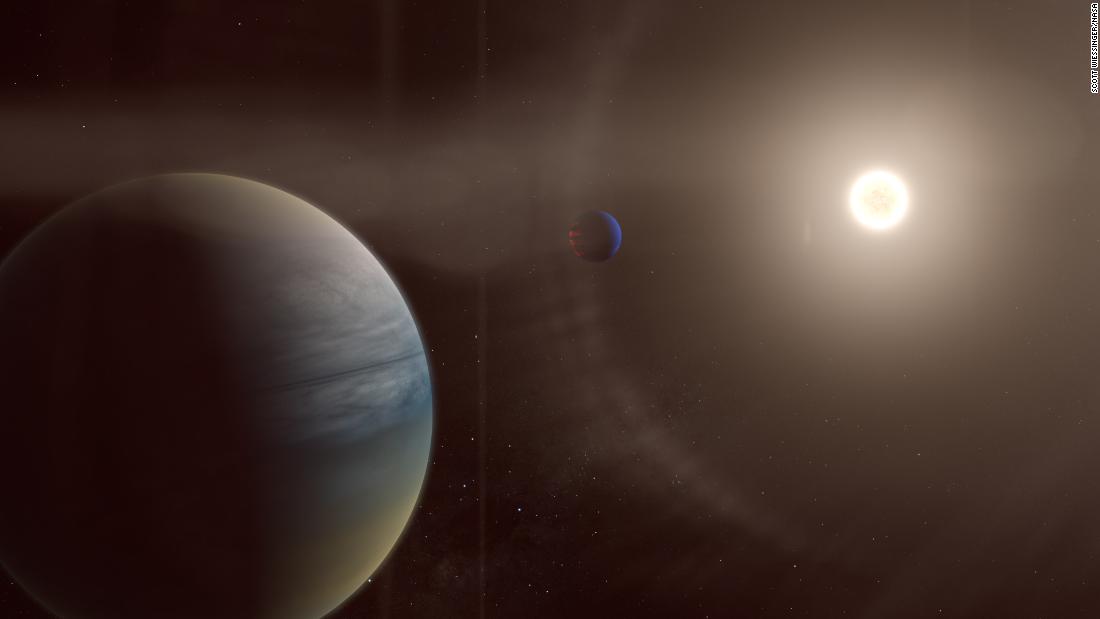
The two exoplanets, which are planets that orbit stars outside of our solar system, are called planet b and planet c. They orbit a star known as HD 152843, which has a similar mass to our sun but is 1.5 times bigger and brighter.
Their discovery was published earlier this month in the journal Monthly Notices of the Royal Astronomical Society.
Planet b is similar in size to Neptune and about 3.4 times larger than Earth. It completes one orbit around the star every 12 Earth days. The outer planet, planet c, is 5.8 times bigger than our planet, which makes it a sub-Saturn. It has an orbit between 19 and 35 Earth days.
For comparison, if both planets were located in our solar system, they would closely orbit the sun.
Citizen scientists were able to help discover these planets by participating in Planet Hunters TESS. This NASA-funded project, available on the Zooniverse website, includes more than 29,000 people around the globe. It allows people to help search for exoplanets using data from NASA's Transiting Exoplanet Survey Satellite, or TESS mission.
The planet-hunting satellite launched in April 2018 and so far, the mission team has identified more than 100 exoplanets and discovered over 2,600 planet candidates that need to be confirmed.
Volunteer citizen scientists use publicly available TESS data to search through graphs that showcase the brightness of stars that the satellite has observed, called light curves. If any of these stars show a dip in brightness, it could suggest that a planet has passed in front of the star during orbit, which is called a transit.
If multiple people submit the same light curves, an algorithm collects them for researchers to analyze. This way, they have exoplanet candidates they can follow up on. It helps to have human eyes on these light curves because computers aren't always able to correctly identify potential planets because it's easy to mistake other phenomena for planets.
"That's why a lot of exoplanet candidates are missed, and why citizen science is great," said Nora Eisner, a doctoral student in astrophysics at the University of Oxford in the United Kingdom and lead author of the study, in a statement.
The information collected by citizen scientists about HD 152843 was analyzed by researchers and compared with models. They determined that two transits were made by the planet closest to the star, planet b, while a third observed transit likely came from the outer planet, planet c.
Follow-up observations of the star were made using the the Extreme Precision Spectrometer instrument at Lowell Observatory in Flagstaff, Arizona, and HARPS-N, or the High Accuracy Radial velocity Planet Searcher for the Northern hemisphere, at the Telescopio Nazionale Galileo in La Palma, Spain.
This provided further confirmation of the planets by using the radial velocity method, which tracks the wobble of starlight as planets orbit a star.
More data and observations will allow them to determine the masses of both planets.
While both planets are too hot and gaseous to support life, they provide more information about the variety of planets to be found outside of our solar system. Future observation of these planets by the upcoming James Webb Space Telescope, set to launch in October, could determine whether the exoplanets have atmospheres and if so, what they're made of.
"We're taking baby steps towards the direction of finding an Earth-like planet and studying its atmosphere, and continue to push the boundaries of what we can see," Eisner said.
The citizen scientists who participated in the study were also made coauthors of the research.
One of those coauthors is Cesar Rubio, the father of a 7-year-old son named Miguel who loves talking about planets and stars with him.
"I try to nurture that," said Rubio, a machinist in Pomona, California, who makes parts for mining and power generation equipment. "I feel that I'm contributing, even if it's only like a small part. Especially scientific research, it's satisfying for me."
https://www.cnn.com/2021/06/22/world/exoplanets-nasa-citizen-science-scn/index.html
2021-06-22 11:04:00Z
CAIiEDapMYs6Who5CU9UzgVyvUEqMwgEKioIACIQpzoRSNLEm6QR--MasMLSAioUCAoiEKc6EUjSxJukEfvjGrDC0gIw1anKBg
Bagikan Berita Ini















0 Response to "Two new gaseous planets found by citizen scientists - CNN "
Post a Comment